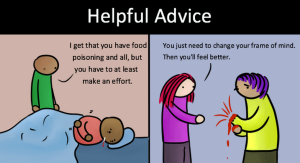
Source: Tiffany Dawn
So often as survivors of sexual violence, we are in a constant state of isolation.
These histories of violence are on our bodies and in the back of our minds, and yet we don’t always share our stories — for so many reasons. Fear of rejection, societal pressure, misunderstanding, being treated as fragile — all of these issues are constantly pushing us further into isolation. We stay silent.
But what happens when we want to share our stories, when we want those who care about us to know who we are, where we’ve been, and where we want to go?
It’s hard to figure out the steps it takes to build that sort of intimacy with the ones we care about and who care for us. Living in a culture that is centered on sexual violence doesn’t make it any easier, and the threats of being triggered are around every corner.
I’ve gone over this in my head many times when thinking about sharing my story with friends.
I, too, stayed silent about my experience for a long time. I was afraid of how people would see me once they knew me.
But once I started opening up and had both negative and positive experiences, I knew it was time for me to talk about my progress.
And after sharing those experiences with friends, some of them also survivors, I saw the need for creating a resource on how to share — since we are more often in the practice of keeping to ourselves.
Step 1: Assess Your Emotional Needs
Navigating where you are in your journey of healing is important when assessing your needs.
Know that where you are can be at any point in your life. It can be the day after the attack, weeks later, months later, or even ten years down the line.
And it’s also possible that you may not know where you are in the process.
As survivors, sometimes the process can be one of highs and lows. At some points, we may feel stable, but then anything can trigger our psyche and cause us to go back into a state of not knowing what to do or how to feel. Building intimacy with a new lover, an interaction in a public space, a conversation in a class or meeting, or maybe just a dream or thought can send us back.
Healing, for me, has been a constant back and forth. Only recently have I been in a consistent state of stability. Being able to go weeks without being triggered is the best feeling ever. Having someone close to us throughout these hard times can be comforting.
We may not know where we’re at all the time, but we are never alone in not knowing.
But understanding how we feel – whether that means being able to put a name to it or not – is the first step in asking for the support that we need.
Step 2: Take Inventory of Your Support System
Having multiple friends means knowing who can help us with each need we may have. One friend doesn’t have to – and honestly, simply can’t – be there for every need. Because there are multiple spaces in our lives that need to be filled, it makes sense to seek out the help of multiple individuals.
Our friends have different strengths and weaknesses, and by taking inventory of how the people in our support system can (and can’t) help us, we can play to those strengths and weaknesses to get the help that we need.
For example, some of our friends may be able to sit and listen to us tell our stories, but may not be able to come along with us while taking any sort of action.
And then maybe other friends might not want to sit and talk with you about the experience, but may be able to help navigate everyday tasks while we are on the road to healing.
Figure out who can offer what, and go from there.
If, after taking inventory of the people in your life, you realize that you have only one friend to whom you’re comfortable talking, think about how much you want to open up to them and how you think (realistically) they’ll be able to support you. This is a good way to take inventory of how you’ll go about asking for support.
Ask yourself: Does my friend know that they’re the only person I can talk to? What types of conversations have we had in the past? This can help you gauge how to go about initiating conversation.
There are a few steps that you can take to make sure that your friends can give you the help you need. According to Penn State Altoona’s Sexual Violence and Assault Awareness resource list, there are a few pointers we can give friends that want to be there for us: They can listen, research, reassure us, empower us, be patient with us, and ask us questions.
Having an idea of who can help and how helps guide the conversation and takes the pressure off people to carry all of the weight of your trauma.
Step 3: Consider Your Needs
When thinking about having any type of conversations with our friends, it’s important to think about what we want. When thinking of sharing stories about sexual violence, those needs may be wanting to feel validated, secure, and whole, in control of what happens to our bodies and minds, and needing to feel free of blame.
Friends are there to help us fulfill these needs, but it’s important for us to understand what our needs are so that we can ask for them. There are some things to think of when initiating these conversations:
Are you opening up recently after the attack or opening up further on your journey to healing? Unpacking during both of these stages can be difficult so thinking of what you want out of these conversations needs to happen before going into them.
Sometimes opening up can come easy, especially if you’re already having conversations about the intersections of race, gender, and sexuality. Bringing up your story and talking about how it has affected your life experience can help build on the conversation.
But other times, opening up is hard and involves initiating conversation.
Think about what you want out of the conversation. Do you just need your friend to listen? Do you need some sort of action? Think about what that action may be and let your friend know what you need their help with.
Confidentiality is definitely something that needs to be thought about before having these conversations. Do you want your friend to keep what you’ve talked about between just you two? Is it okay for them to talk to your other friends about it — especially if you don’t want to have this conversations multiple times? Do you want them to discuss things with your family?
I like to keep things between me and the person(s) I choose to talk to.
So, considering this, it’s important you trust the people you’re talking to. Let’s be honest, some of us have friends that like to talk. So maybe those friends aren’t the ones we need to share our stories with.
Step 4: Consider Your Friends’ Needs
Sharing of narratives is mandatory in friendships. It’s how you continue building the relationship. But we also need to consider how our friends might handle and react to our sharing.
In this way, it is desperately important that we ask our friends if it is okay to talk about sexual violence with them.
Talking about violence can be triggering for those close to us, so asking for consent before having this conversation may be needed (particularly if you’ve never had a conversation on sexuality or sexual violence before).
But also, it’s important to remember our friends may know the person(s) involved that we’re going to talk about.
Of course this shouldn’t silence us, but we should bring up that our friends may be close with who we’re going to tell them about. Letting them know we don’t need them to pick sides is important. We just want to talk about what’s happened and what’s going on.
Also let your friends know it’s not their job to go after said person even if they know them. Sometimes that sort of thing just makes the situation worse.
This is where the confidentiality mentioned above comes into play. Getting more people involved can just make anxieties heighten and the healing process more complicated.
Understand that your friends are going to have reactions, and think through how you can manage those reactions in a way that is mutually beneficial to you and to them.
Step 5: Have the Conversation
Once you’ve taken inventory and figured out your needs and thought about the possible needs of your friends, it’s (finally) time to talk! But there are a few considerations that you probably want to think through to ensure safety and comfort.
For example, make sure that you’re in a comfortable environment. Maybe that’s a quiet place — your house, their house, a secluded public space – or maybe you want to be in a space where there is a lot going on so you won’t feel like all the attention is on you and your friend having this conversation. Pick what’s best for you.
Also think through whether or not to tell your friend ahead of time what you want to talk about or if you’re just going to bring it up with them in the moment.
Maybe you’ve already told your friend what you’re going to be talking about and you’ll just go from there once you meet up.
But if not, starting off the convo with something like “I’ve had something on my mind for a while now and thought it would be good to let you know” or “ _____ has happened to me, and I need ______ from you if possible” can get things going.
After starting the conversation, there’s unfortunately no way to know what might happen. And that’s scary, but it’s okay.
If at any point you feel uncomfortable, it’s okay to stop the conversation. You don’t need to be sorry about it either. Having a conversation like this takes a lot of energy out of us. There is no need to be sorry about needing to pause the conversation or deciding in the middle of talking that you can’t continue.
It’s also possible that your friend may not want to continue the conversation. That’s okay! It’s no reflection of what’s happened with you. What’s important is asking our friends if they’re okay, making sure they know we want them to be there for us, and asking them how they can be there for us so we know how to navigate initiating these conversations with them.
Some friends, we won’t be able to talk with. But there will be others who will be able to talk with us.
They will hear us out about our stories, let us cry, maybe cry with us, get angry with us, and share that pain. They will listen and tell us how they can be there.
Step 6: Self-Care and Follow-up
Self-care is a very important step to take when going through the process of opening up to friends about histories of sexual violence.
Taking care of mental health is so important – in general, but especially considering that these conversations can bring the best and worst out of our friends and that can take a toll on mental stability.
The self-care process looks different for everyone, but when I think of what can come from these conversations, I think of a few things to remember:
- Letting friend(s) know your history and how it affects who you are in the present does not make you fragile
- We are worthy of the types of friendships we crave
- Our individual narratives are not up for comparison
- We are not at fault if our friends decide to distance themselves from us after we share our stories with them
After having these conversations, I like to talk about something completely different. Talking about something my friends and me like to do is a great way to lift the vibe and release the anxiety I get from having these conversations.
I also love just having some sort of intimate moment — maybe a hug that lasts a while, or just sitting in silence with my head on a friend’s shoulder. I almost always find comfort over food. Cooking a meal with a friend after having these conversations is a great way to relax.
What’s important, though, is that you find what works for you. Think through places, people, and activities that make you feel safe, and make sure that you have a plan to engage with them when the conversation is over.
***
Creating community through sharing our history with sexual violence is an empowering and revolutionary act.
Society tells us to be quiet and accept what has happened and deal with it alone because talking about sexual violence isn’t something to speak aloud on. It is something that is hushed.
Society, then, also shames us for our silence whenever we do decide to speak out publicly. We are constantly reminded that we are wrong, our bodies and being are to blame, and that because of what we’ve “allowed” to happen to our bodies, we should be in constant state of question and suspicion.
But our bodies and our experiences aren’t anything to be ashamed of. When we share in whatever way that might be, we create space for healing.
Speak up and speak out in whatever way empowers you.
[do_widget id=”text-101″]
Rahel Neirene is a Contributing Writer for Everyday Feminism. She’s a Black Queer Femme from the South focused on forming and studying connection and the actions and art that can be created around it. She is passionate about Black women and other women of color sharing their stories of self-evolution, empowering women to embark on journeys of radical self exploration and reflection. She believes that forms of self-love and self-care are acts of social justice. When Rahel isn’t talking with her loves (friends) and community about the importance of love and connection, she is building intimacy with her people through food, creation of music and other art forms, and laughter. Read her articles here.
Search our 3000+ articles!
Read our articles about:
Our online racial justice training
Used by hundreds of universities, non-profits, and businesses.
Click to learn more




















